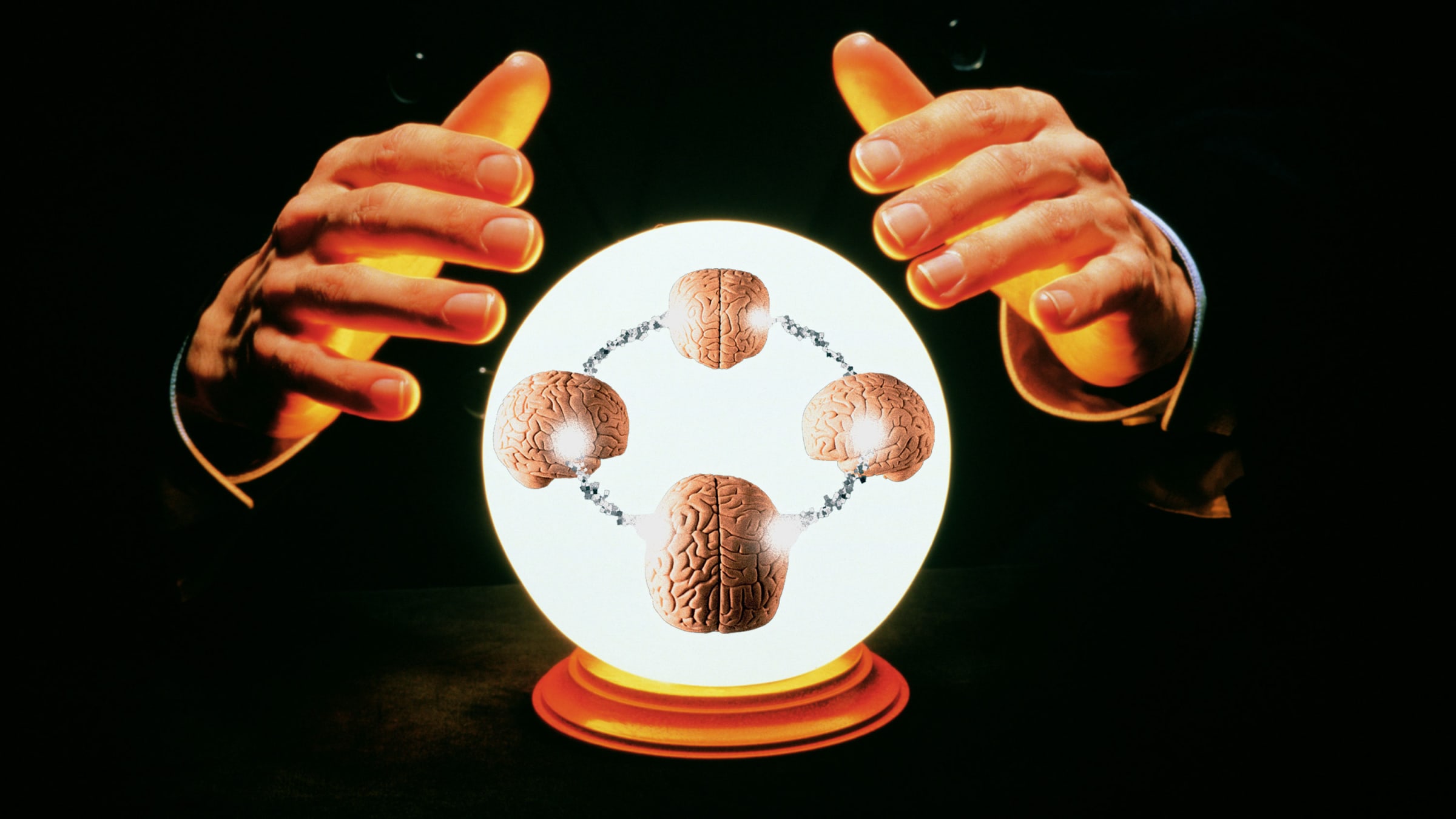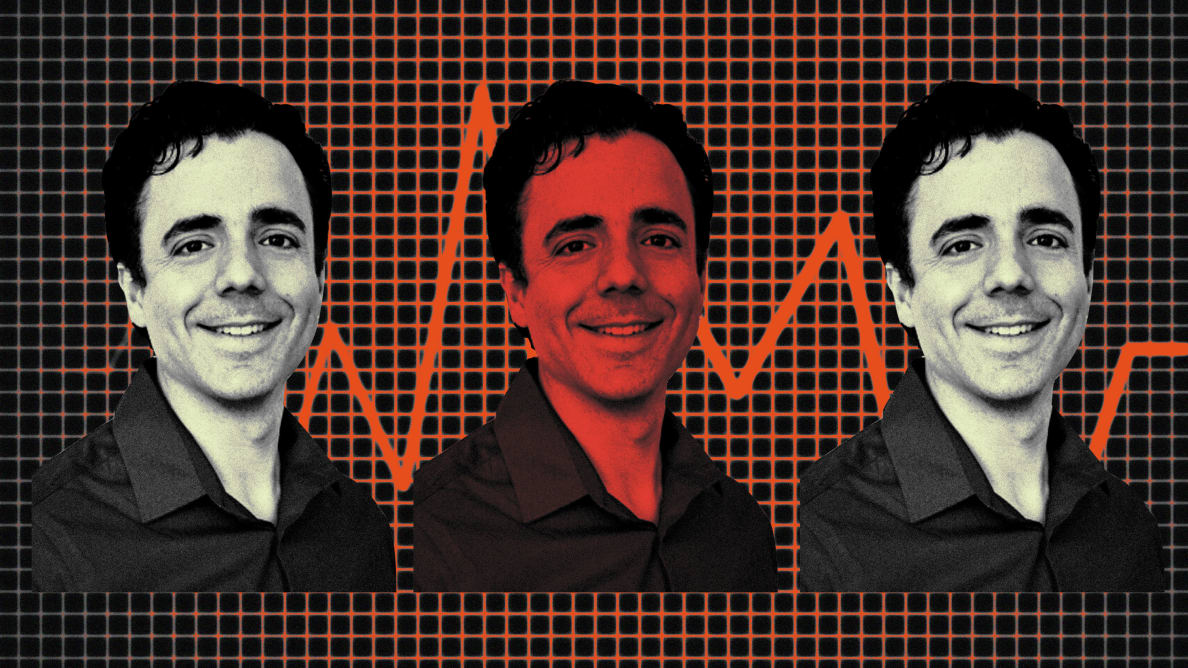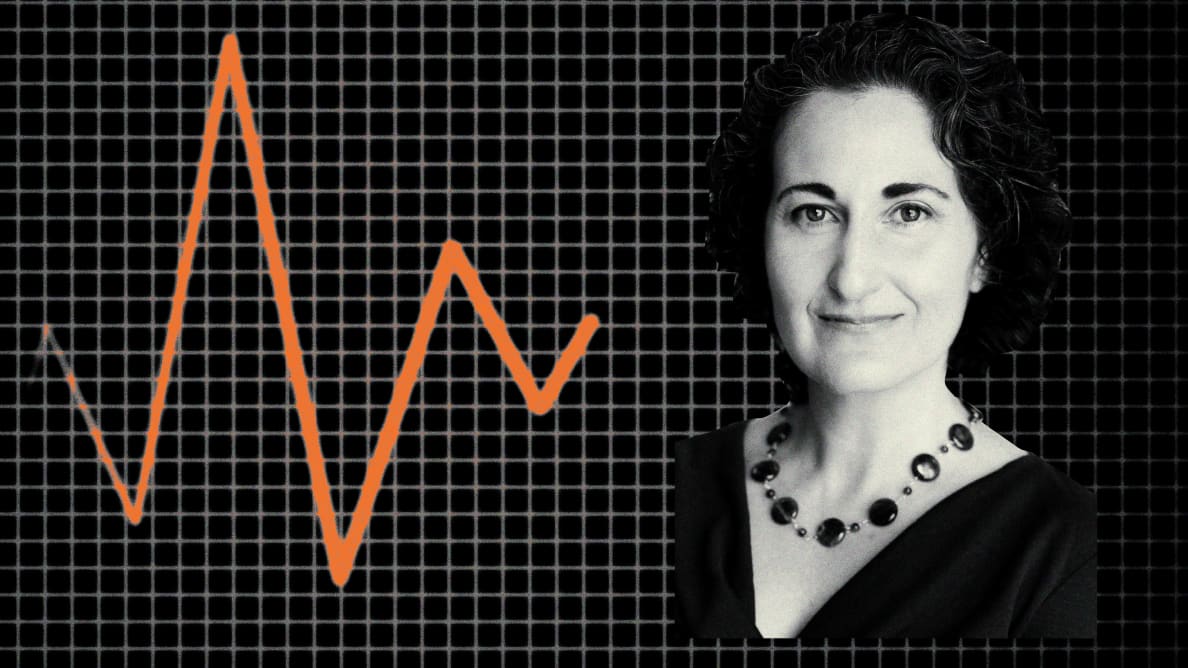How a Former Columbia Professor Fell Deep Into ‘Psychic’ Pseudoscience

Photo Illustration by Kelly Caminero / The Daily Beast / Getty
We don’t expect Ivy League researchers to start dabbling in pseudoscience, but it’s more common than you might think.
Spiro Pantazatos doesn’t seem to mind that his research interests lie off the beaten path.
“I’ve always been fascinated by research topics that don’t tend to get a lot of attention or funding for whatever reason—if they’re considered taboo, for instance,” the clinical neurobiology researcher told The Daily Beast.
For the most part, his citations would be considered par for the course for any scientist who studies the brain. His work includes a bevy of papers showing the brain’s role in everything from depression to obesity. There’s nothing peculiar about these avenues of research—it’s well-established that such links exist, even if the specifics are still being pieced together.
But there are a few clues into Pantazatos’ penchant for the unconventional.
Take his 2014 paper published in the journal NeuroImage: Looking at birthdates and brain scans, Pantazatos related a person’s birth season to specific differences in their brain’s structure and function, when separated by sex. At the time, Wired called the results “intriguing.”
The project sparked a more ambitious idea to validate these trends more thoroughly. Datasets of American patients do not contain birthdates, since they’re considered a form of protected health information under the Health Insurance Portability and Accountability Act (HIPAA). But perhaps, Pantazatos thought, he could source brain scans and personal information directly from volunteers—“cut out the middleman,” he said.
By 2021, Pantazatos, then a faculty member at Columbia University, had set up the project with $10,000 in funding from NYC Media Lab, an accelerator for early-stage media and technology startups. A new organization called IONS, based in Novato, California, had joined the research, helping recruit participants and guiding its direction. Called My Brain and Me, the project asked a range of survey questions from people who submitted their brain scans, including a specific set designed in collaboration with IONS.
In a post titled, “Columbia University to Study the Neuroanatomy of Psychic Abilities,” IONS described the newest goal of the project. “There is an ever-growing body of evidence that psychic abilities like telepathy, psychokinesis, astral projection, and channeling are not only real—they’re quite common,” the post read. My Brain and Me would help answer the question of whether psychic experiences could be mapped to certain regions of the brain.

Spiro Pantazatos.
Photo Illustration by Kelly Caminero / The Daily Beast / Getty / Photo by NYC Media Lab Combine
But there’s a massive problem with this premise, Yale School of Medicine neurology researcher Steven Novella told The Daily Beast: “It is completely not true.”
“There is no growing body of evidence for any of these phenomena,” Novella added. “In fact, after 100 years of study, they’ve made no progress whatsoever.”
My Brain and Me meant that Pantazatos had leapt from the unconventional to the outright controversial. The study of psychic abilities—often called psi or noetic sciences by its believers, and parapsychology or even simply pseudoscience by mainstream scientists—is undoubtedly a fringe topic. Yet its reach, demonstrated by researchers like Pantazatos and an organization like IONS, has moved off from the fringe. Experts told The Daily Beast that growing frustrations in scientific publishing and academic freedom got us here, and it will take a substantial reform of both systems to separate fact from fiction.
Extraordinary Claims
The founding focus of IONS, according to the nonprofit organization’s website, is to reveal “the interconnected nature of reality.” This aim might appropriately be described as otherworldly: the late Apollo 14 astronaut Edgar Mitchell founded the Institute of Noetic Sciences in 1973, two years after he became the sixth man to walk on the moon. He described having an epiphany about universal interconnectedness as his spacecraft headed back to Earth, and would cite this experience as a major reason for starting IONS.
With this general goal in mind, the organization’s priorities have significantly shifted in the past several decades, IONS Director of Research Helané Wahbeh told The Daily Beast. Its research arm, launched two decades ago, is a relatively new addition to IONS’ broader programming of education and events—yet it has taken over as one of the organization’s marquee enterprises. From June 2020 to 2021, research expenses totaled more than $760,000, nearly 20 percent of IONS’ annual expenditures. An additional $100,000 research prize for work in the noetic sciences was announced on March 29.
“IONS really prides itself on being the trailblazer and the front of the pack in terms of frontier science,” Wahbeh said.
What exactly this area entails can span a range of experiences and “extended human capacities,” Wahbeh said. Decades ago, IONS was a prominent supporter of mindfulness meditation when people in the West were skeptical of it; today, the institute invites people to share “specific and remarkable” experiences they have had, like telepathy, precognition, and clairvoyance.
It’s the organization’s parapsychological endeavors that elicit real criticism from its skeptics today. IONS recruits participants for research studies—rating photos to be used in a remote viewing study, or teaming up with a partner who could be miles away and guessing if you’re both viewing the same photograph. Pantazatos’ study is highlighted on the website, too. Wahbeh said the research question that IONS is most interested in is whether specific brain regions can be linked to any of over a dozen different noetic experiences.
In line with Mitchell’s epiphanic experience with universal interconnectedness, IONS’ overarching research aim is to find evidence for “big-C consciousness,” Wahbeh said. “Neuroscientists are always studying consciousness, but that’s about whether we’re awake or not,” she said. Consciousness, to IONS, represents a fundamental feature about the physical world, and a phenomenon that does not just happen in the brain.
Novella, the co-founder of the New England Skeptical Society, approaches these parapsychological elements (e.g., psychic experiences) with a high degree of what he calls scientific skepticism, which he defines as “a rigorous application of scientific methodology, critical thinking, and media-savvy scientific literacy, to all factual questions.” Essentially, the scientific method on steroids.
“We don’t have to spend a lot of our effort dealing with mainstream scientific questions because there are scientists that are doing that,” Novella added. “But for those questions that are more out on the fringe, we pay particular attention because they generally lack scientific rigor.”
A perfect example of why this skepticism is necessary, Novella said, is a series of contentious studies called “Feeling the future,” published by Cornell University social psychologist Daryl Bem. Beginning with a 2011 study published in the Journal of Personality and Social Psychology, Bem presented results that he interpreted as evidence of precognition, an ability of the body to recognize events before they occur. In the first set of studies, he showed 100 Cornell undergraduates a computer screen with two sets of curtains, one of which contained an image behind it. He asked the students to select the curtains they believed contained a pre-selected neutral, negative, or erotic image.

Helané Wahbeh, director of research at IONS
Photo Illustration by Kelly Caminero / The Daily Beast / Getty / Photo by In Her Image Photography
Analyzing the results of 36 trials per participant, Bem found that the students’ accuracy at identifying neural and negative images was no better than random chance, but that they chose the correct curtain obstructing an erotic image 3.1 percent more often than pure guesswork would predict. He calculated a statistical p-value that showed the results were significant, which scientists take to mean that the findings are unlikely to be due to random chance.
This statistical maneuver—separating out the nonerotic and erotic images, and pointing to one measure of significance as evidence for precognition—drew criticism from other academics. They pointed to Bem’s research and other studies claiming to validate the existence of psychic abilities as prime examples of “p-hacking,” or cutting up data to achieve a statistically significant p-value.
Equally concerning, Novella said, was that several researchers independently tried to replicate Bem’s findings and failed. When they approached the same academic journal that published the first “Feeling the future” study, however, the new paper was rejected, even though it followed the same methodology. On a large scale, this odd phenomenon is known as publication bias and explains why research that reaches inconclusive or negative conclusions is less often published than studies that present new or surprising results.
The series of events here, said Novella, indicates a deeper problem: Fringe research can capitalize on the biases built into for-profit scientific publishing, in order to turn unserious scientific findings into mainstream ideas.
“The system really isn’t optimized for the quality of the research itself, it’s optimized for the business model of what's putting the journal out there,” he said. “We need to think very carefully about how to remove some of the blatant perverse incentives, and we need to figure out ways of setting the bar a little bit higher for saying, ‘This is a published, peer-reviewed study.’”
Wahbeh said she is surprised by the passion that some critics of the noetic sciences bring to discussions about it. She argued their skepticism might come from a number of places, such as an unwillingness to question established scientific paradigms and a history of religious persecution for those reporting psychic experiences.
Or perhaps, she said, those critics fear a world in which psychic abilities exist.
“They’re afraid of their own potential, and they’re afraid of what it would mean if humanity actually fully expressed these potentials,” Wahbeh said. “Let’s say I’m just fully telepathic, and I know exactly what you're thinking right now. That would make you feel really uncomfortable.”
On the other hand, she said she doesn’t think of concepts within the noetic sciences of being purely correct or incorrect. The evidence might come to support certain aspects, like precognition, channeling, or telepathy, more strongly than others. But she advocates for more study into reported psychic abilities, even if research disproved its existence.
“If people find definitive proof that intuition is not real, but ‘Susan’ gets intuitive hits every day that support her in her life—that allow her to feel happy, fulfilled, connected in her relationships, and allow her to make decisions to feel supported by her community—to me, that deserves studying,” Wahbeh said.
An Unlikely Partnership
Before Pantazatos began collaborating with IONS, he had already successfully presented My Brain and Me at an NYC Media Lab event and gotten positive feedback on the idea. In addition to crowdsourcing information and brain scan data from participants, he taught himself how to code and created a tool that created an easy-to-understand brain visualization out of uploaded scans, revealing participants’ neural similarities and differences from one another. With the collected scans, Pantazatos could start to look at different characteristics—history of neurological illness or birthdate, for instance—and see how any brain structures or activity might be associated.
Even so, it had been difficult to secure funding for My Brain and Me. The NYC Media Lab award was nice, but his grant applications to the National Science Foundation and National Institutes of Health had been rejected. After learning about IONS, Pantazatos approached the organization about collaborating on the project in some capacity. The two parties created a survey to ask participants about reported psychic experiences. Once they collect enough data, Pantazatos will use the questionnaire responses to test any neurological underpinnings of reported psychic experiences, he said.
IONS has been helping to recruit participants for My Brain and Me by posting about it on its website and sponsoring Facebook ads, Wahbeh said. “Spiro has the platform where people upload their scans, and IONS has the networking power to put the word out about it.”
But there’s reason to believe that IONS may get something from this partnership too, Kavin Senapathy, an independent journalist who covers pseudoscience, told The Daily Beast. Being associated with a Columbia University faculty member may lend undue credibility to IONS’ mission.
Asked about the IONS blog post’s title, (“Columbia University to Study the Neuroanatomy of Psychic Abilities,”) Pantazatos agreed that Columbia’s prestige may have played a role in the project’s framing. “I think that is probably a decision that they made to maybe sell the project a little bit more, and add credibility,” he said.
But, he added, “I’m the person who's leading the project.” That he didn’t ask for the university’s permission before collaborating with an organization like IONS is an example of academic freedom and free inquiry that Columbia encourages in its student body and community members, he said.
Too often, however, academic freedom crosses the line into university-endorsed pseudoscience, Novella said. In the 1990s, John Mack, an award-winning Harvard University psychiatrist, made headlines after he announced he believed the claims of patients who said they had been abducted by aliens. Mack’s tenure and the issue of academic freedom all but ensured he would remain at Harvard, even as colleagues questioned his extraordinary claims.
“What are they going to do? They’re going to fire somebody who’s got some weird hobby? They usually don’t do that,” Novella said. “Of course, then that leaves people like you to ask the question, ‘Well, how is this guy affiliated with an actual university when he's doing pure pseudoscience?’
“Academia, in general, needs to be better at requiring a higher level of scientific rigor and critical thinking,” he added, “because they do lend their name and their institutional reputation to a lot of nonsense.”
It’s not just the university at fault for edging pseudoscience closer to the mainstream. Senapathy said that it’s often difficult for the public to recognize that a person lacks expertise in one field when they have prominently excelled in another. Mitchell, the founder of IONS, is a perfect example, she said.
“The conjectures of Edgar Mitchell were granted legitimacy because he’s a member of this prestigious club of folks who have walked on the moon,” Senapathy said. “Even in science, mediocrity often comes packaged with what we see as greatness in the same individual or within an organization.”
Unboosted
IONS’ participation in My Brain and Me was announced at the end of June 2021, but by December, a pressing concern began to bubble up for Pantazatos. The university sent out a note to faculty, staff, and students updating its guidelines for COVID-19 vaccines and mandating that eligible community members receive a booster dose. Months earlier, Pantazatos had sent emails to Columbia’s leadership advocating against booster mandates and warning about adverse events. (Some vaccine trials have suggested that there is a possible increased risk of inflammation of the heart muscle or outer lining of the heart—called myocarditis and pericarditis, respectively—following COVID-19 vaccination in young adult and adolescent males. Still, the Centers for Disease Control and Prevention recommends that everyone six months and older get vaccinated for COVID-19, as the risks of the illness far outweigh any rare reaction to the vaccine.)
After voicing these concerns, Pantazatos said that he was retaliated against by university administration. He wrote in an opinion piece published this January in the Columbia Daily Spectator that his paychecks and insurance were “inexplicably paused” in January 2022, only to be reinstated months later. Then, in August 2022, his Columbia faculty page was removed, and he was asked to move out of his office in September.
Pantazatos said that he received a medical exemption and submitted a reappointment package in February of this year, but had not heard back about its status as of late April. A Columbia University spokesperson confirmed to The Daily Beast that Pantazatos is no longer affiliated with Columbia Psychiatry, but did not respond to specific questions about Pantazatos’ work and relationship with IONS by the time of publication.
The whole series of events has even inspired Pantazatos to add a new facet to My Brain and Me. Soon, he said, he’ll be crowdfunding to expand the platform to study the neurological basis for vaccine injuries.
“On some level, I’m taking it in stride and enjoying having to be creative,” he said. “I never wanted to be completely reliant on the university as a main source of income because I knew at some point—I think it’s inevitable someone's going to say something that gets them canceled.”
